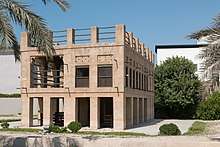Jumeirah
Jumeirah (Arabic: جُمَيْرَا, romanized: Jumayrā Emirati pronunciation: [dʒʊˈmeːrɐ]) is a coastal residential area of Dubai, United Arab Emirates mainly comprising low rise private dwellings and hotel developments. It has both expensive and large detached properties as well as more modest town houses built in a variety of architectural styles. The area is popular with expatriates working in the emirate and is familiar to many tourists visiting Dubai.[2]
Jumeirah جُمَيْرَا | |
|---|---|
Community | |
 Aerial view of Jumeirah from the Burj Al Arab | |
| Coordinates: 25.202°N 55.244°E | |
| Country | United Arab Emirates |
| Emirate | Dubai |
| City | Dubai |
| Boroughs | List
|
| Area | |
| • Total | 6.9 km2 (2.7 sq mi) |
| Population (2000)[1] | |
| • Total | 26,499 |
| • Density | 3,800/km2 (9,900/sq mi) |
History

Archaeological excavations at Jumeirah Archaeological Site,[3][4][5] which was discovered in 1969, demonstrate that the area was inhabited as far back as the Abbasid era, approximately in the 10th century CE. At this time, it appears to have been the coastal part of an Eastern Arabian subregion referred to as 'Tawam', which comprises the city of Al Ain in the Emirate of Abu Dhabi, and the adjacent Omani town of Al-Buraimi.[6][7] Measuring about 80,000 m2 (860,000 sq ft), the site lay along a caravan route linking India and China to Oman and Iraq.[3][4][5]
Historically, Emirati people living in Jumeirah were fishermen, pearl divers and traders. At the turn of the 20th century, it was a village of some 45 areesh (palm leaf) huts, inhabited mainly by settled Bedouin of the Bani Yas and Manasir tribes. At the time, Jumeirah was 'about 3 miles southwest of Dibai town'.[8]
In modern times (1960 onwards), Jumeirah was the principal area for western expatriate residences. The beachfront area was previously called "Chicago Beach",[9] as the site of the former Chicago Beach Hotel.[10] The locale's peculiar name had its origins in the Chicago Bridge & Iron Company which at one time welded giant floating oil storage tankers called 'Kazzans' on the site.[9] The old name persisted for a time after the old hotel was demolished in 1997. "Dubai Chicago Beach Hotel" was the Public Project Name for the construction phase of the Burj Al Arab Hotel until Sheikh Mohammed bin Rashid Al Maktoum announced the new name - Burj Al Arab.[10]
References
- Existing Population and Future Holding Capacities in Dubai Urban Area (2000) Archived 2008-09-11 at the Wayback Machine. Dubai Healthcare City. 2000
- "Jumeirah". propertyfinder.ae blog. 2014-11-09. Retrieved 2018-11-05.
- Al Amir, Khitam; Cherian, Dona (2020-01-09). "Look: Sheikh Mohammed Bin Rashid visits Jumeirah Archaeological Site". Gulf News. Retrieved 2020-01-12.
- "Mohammed bin Rashid visits Jumeirah Archaeological Site". Emirates 24/7. 2020-01-09. Retrieved 2020-01-12.
- "'Happy and proud' Ruler of Dubai meets archaeologists at Jumeirah dig site". The National. 2020-01-09. Retrieved 2020-01-12.
- Abed, Ibrahim; Hellyer, Peter (2001). "The Coming of Islam and the Islamic Period in the UAE". The United Arab Emirates, A New Perspective. London: Trident Press Ltd. pp. 73–88. ISBN 978-1-900724-47-0.
- Leech, Nick (2015-10-22). "The long read: has a lost Arab capital been found on the Oman-UAE border?". The National. Retrieved 2019-01-20.
- Lorimer, John (1915). Gazetteer of the Persian Gulf Vol II. British Government, Bombay. p. 454.
- Krane, Jim City of Gold: Dubai and the Dream of Capitalism, page 103, St. Martin's Press (September 15, 2009)
- "Chicago Beach Dubai". www.dubaiasitusedtobe.com. Retrieved 2016-06-11.
External links
- Jumeirah: Dubai's Most Expensive and Exclusive Area – FlashyDubai
- Jumeirah: Dubai's Best Dental & Skincare Clinic
- Jumeirah Area Guide
Archaeological site
- Jumeirah Archaeological Site, Dubai Culture & Arts Authority
- Lonelyplanet website
Majlis Ghorfat Umm Al-Sheif
- Majlis Ghorfat Umm Al Sheif, Dubai Culture & Arts Authority
| Wikivoyage has a travel guide for Dubai/Jumeirah. |
| Wikimedia Commons has media related to Jumeirah. |